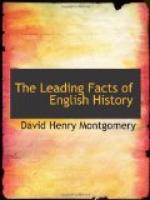145. The Private or King’s Council.
There was also a second and permanent council, called the King’s Council. The three leading officers of this were: first, the Chief Justice, who superintended the execution of the laws, represented the King, and ruled for him during his absence from the country; secondly, the Lord Chancellor (so called from cancelli, the screen behind which he sat with his clerks), who acted as the King’s adviser and confidential secretary, and as keeper of the Great Seal, with which he stamped all important papers;[1] thirdly, the Lord High Treasurer, who took charge of the King’s revenue, received all moneys due the Crown, and kept the King’s treasure in the vaults at Winchester or Westminster.
[1] The Lord Chancellor was also the “Keeper of the King’s Conscience,” because intrusted with the duty of redressing those grievances of the King’s subjects which required royal interference. The Court of Chancery (mentioned on page 73, note 1) grew out of this office.
146. Tallies.
All accounts were kept by the Treasurer on tallies or small sticks, notched on the opposite sides to represent different sums. These were split lengthwise. One was given as a receipt to the sheriff, or other person paying in money to the treasury, while the duplicate of this tally was held by the Treasurer. This primitive method of keeping royal accounts remained legally in force until 1785, in the reign of George III.
147. The Curia Regis,[2] or the King’s Court of Justice.
The Chief Justice and Chancellor were generally chosen by the King from among the clergy; first, because the clergy were men of education, while the barons were not; and next, because it was not expedient to intrust too much power to the barons. These officials, with the other members of the Private Council, constituted the King’s High Court of Justice.
[2] Curia Regis: This name was given, at different times, first, to the Great or National Council; secondly, to the King’s Private Council; and lastly, to the High Court of Justice, consisting of members of the Private Council.
It followed the King as he moved from place to place, to hear and decide cases carried up by appeal from the county courts, together with other questions of importance.[1] In local government the country remained under the Normans essentially the same as it had been before the Conquest. The King continued to be represented in each county by an officer called the sheriff, who collected the taxes and enforced the laws.
[1] The King’s High Court of Justice (Curia Regis) was divided, about 1215, into three distinct courts: (1) the Exchequer Court (so called from the chequered cloth which covered the table of the court, and which was probably made useful in counting money), which dealt with cases of finance and revenue; (2) the Court of Common Pleas, which had jurisdiction in civil suits between subject and subject; (3) the




